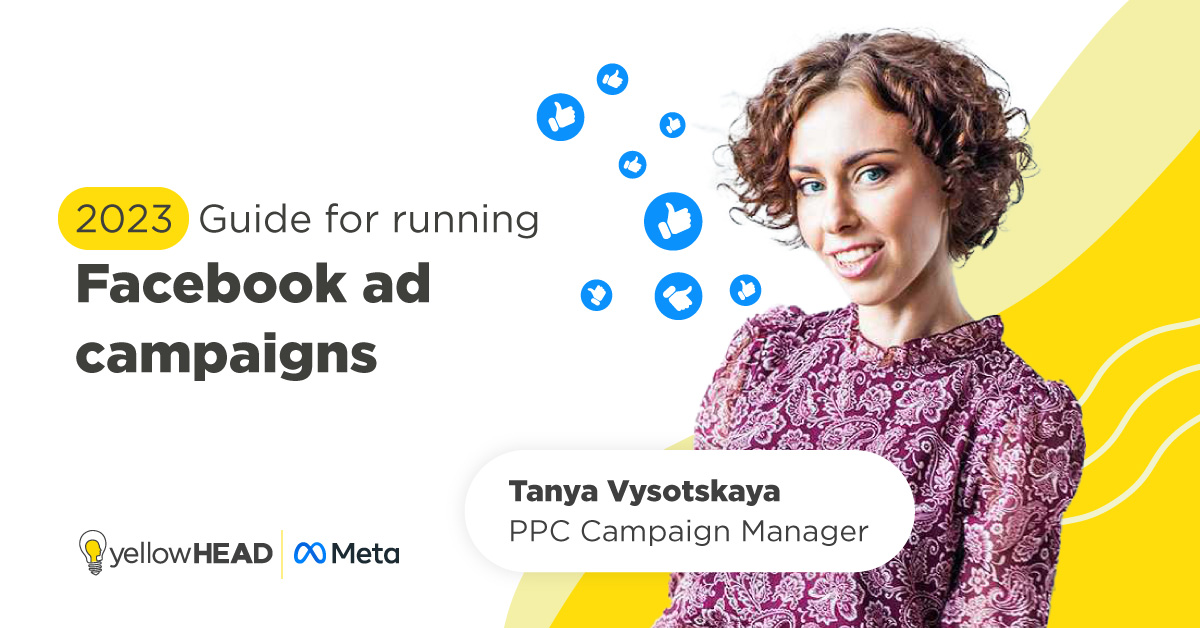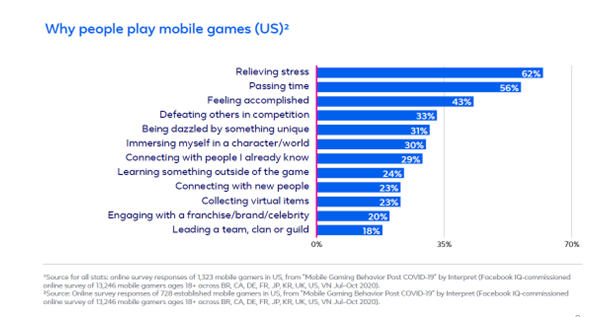Guide for running ad campaigns on Facebook in 2023
Welcome to the guide for running ad campaigns on Facebook in 2023! With over 2.8 billion monthly active users, Facebook provides a vast audience for businesses to reach and engage with potential customers. In order to set up an ad campaign on Facebook it’s essential to approach it strategically to ensure maximum impact and success. In this guide, we will walk you through the steps to create Facebook business activity, optimise it for your target audience, and leverage Facebook’s tools and features to grow your business.
Preparation is key before taking any action, and launching a new ad campaign is no exception. It is crucial to consider what is required for a successful launch and ensure that all necessary components are in place.
The main stages are:
1. Tracking – App integration, events set up, MMP integration
2. Creative – Campaign assets (creative concepts, creative production, copies)
3. Target Audience – Who you are addressing and why
4. Optimization – Goal and budget
1. Tracking
The success of User Acquisition (UA) managers heavily relies on their ability to effectively track their campaigns. They must monitor every click, determine the source of every sale, and assign a value to each action. To maximise the benefits of your app ads, it’s important to register your app with the ads platform and integrate the Software Development Kit (SDK). This will allow you to transmit app event data from your app to the ads platform, enabling precise tracking and measurement of user actions within your app.
Benefits of app events
App events can help improve the efficiency and impact of your ads campaigns, and unlock advertising solutions such as:
1. Measurement: After you set up app events, you can see your unattributed and attributed events in the Events Manager. You can also see how many in-app actions are happening as a result of your ads in the Ads Manager.
2. Optimization: Setting up app events enables you to use campaign optimization types such as app event optimization (AEO) and value optimization (VO). These types of campaign optimization can help you find users who are more likely to take valuable downstream actions such as purchasing an item, or help you achieve more efficient return on ad spend.
3. Ad targeting: App events enable you to create app activity Custom Audiences and lookalike audiences. This can help you reach users who are more likely to take actions you care about after seeing your ad.
Registering your app or integrating the SDK is not mandatory to run app ads through the app promotion objective, but your ads will be optimized for link clicks rather than app installs by default. Moreover, your campaign will not track any installs resulting from your ads unless your app is registered and the SDK is properly implemented. After integrating the SDK, you can create and execute app ads via Ads Manager.
Another crucial aspect of tracking before launching a new app promotion activity is integration with a Mobile Measurement Partner (MMP). An MMP is a valuable tool for marketers as it enables them to determine which media source should be credited for driving conversions. By attributing, collecting, and organizing app data, this platform provides a comprehensive evaluation of campaign performance metrics. Simply put, an MMP matches campaign engagements with app installs and post-install in-app actions, serving as an impartial referee for attribution. This empowers marketers to make informed decisions regarding budget allocation. Popular MMP platforms include Kochava, AppsFlyer, and Adjust, among others.
2. Creative
Mobile game advertising has the potential to attract millions of users to your game if executed properly. Video ads, in particular, have shown to generate the highest conversion rates. As William Blake famously stated, ‘The true method of knowledge is experiment.’ Since it’s difficult to predict which approach will be the most successful, it’s recommended to prepare as many ad concepts as possible and test them thoroughly. For valuable insights on top creative performance in 2022, check out our article: https://www.yellowhead.com/blog/top-10-learnings-creative-performance/. When developing creative concepts and messaging, it’s important to keep in mind that 85% of mobile gamers do not identify as gamers (Mediakix). Therefore, it’s crucial to understand the primary reasons why users play mobile games:
- To relieve stress
- Pass the time
- To immerse themselves in another character or world
- To feel accomplished for completing something challenging
- Express something unique about themselves
- To connect with people they already know
- Be dazzled by something unique
- To connect with a subject they’re passionate about outside gaming
And also what influences players to return after 30 days:
- Someone bringing up the game during an in-person conversation
- Hearing about new content or available updates
- Hearing about a reward for coming back
- Seeing the game mentioned on social media by friends/family
- Seeing news articles or blog posts about the game
3. Target Audience
To ensure a positive return on investment (ROI) and attract loyal and high-profit players, it’s essential to identify and target the appropriate audience. The process of determining the target audience can be achieved by considering three main aspects: demographics, psychographics, and motivation. A good starting point is to identify general gamer groups that are relevant to your game’s genre and category keywords, or by examining the list of competitors. Additionally, it’s important to consider the age and gender of your target audience.
Mobile gaming stats:
- According to Mediakix, more than half of gamers are older than 34. The average age of female gamers is 36 and 32 for males.
- 55% of mobile gamers are female, 45% are male. (Statista)
- People older than 45 make up almost a third of mobile gamers. (Mediakix)
- Younger male gamers prefer action mobile games and shooters
- 77% of Gen Z players, 73% of Millennials players, 54% of Gen X players, and 34% of Baby Boomer players play on mobile. (Newzoo)
What should be the targeting audience for your first campaign?
Launching a new activity means that there is no historical data available in the ads manager to create a Lookalike (LAL) audience. Therefore, it’s recommended to start with Interest targeting. However, if the activity is for an app that has been in operation for some time, you may have access to a customer list, such as a Payer’s list, Most Active Payers, Higher Value, or Lifetime Users lists. In such cases, it’s recommended to create 1%, 2%, or 3% LAL audiences based on these lists and conduct tests. The smaller the percentage of the LAL audience, the more specific and relevant the users you target.
4. Optimization
The first step is to select the event that you want to optimize for in your initial ad campaign. This decision will impact the audience that your ads will be shown to in order to achieve your desired outcome. The delivery system leverages machine learning to enhance the performance of each ad based on the optimization you choose. For instance, if you opt to optimize for app installs, the ad platform will display your ad to individuals who are more likely to install your app. If you lack a vast database of similar payers, it is recommended to start with a small-scale launch using app installs as your campaign optimization objective until you have sufficient data to switch to AEO (app event optimization)
Optimisation goals:
- AEO: App Event Optimization (AEO) allows you to optimize your ad delivery using certain standard and custom app events in the App Installs objective. This can help you show your ads to users who are more likely to perform specific actions that are valuable to your app or business. For example, if you want more purchases in your app, you can run mobile app promotion ads optimized for the purchase event.
- VO: When you optimise for value, we use machine learning to predict how much return on ad spend (ROAS) a person may generate. We then use this prediction to bid for your highest value customers. By bidding more for people who are likely to spend more, you can help ensure you are maximising the ROAs for your campaigns. By “value,” we mean how much revenue a person generates within a day or a week (depending on which attribution setting you choose) for a given purchase event. By “optimization,” we mean the result our delivery system is working to get for you.
- Min ROAs: If you 1) need more control over the purchase value you generate from ads than what is possible with the highest value bid strategy or 2) want to keep your return on ad spend around an average amount over the course of your campaign you can set a minimum ROAs control. When you set a ROAs goal, the ads platform will try to deliver against that over the campaign’s lifetime, dynamically bidding as high as needed to maximise results. For example, if you want your budget of $100 to result in at least around $110 in purchases (or a 110% return), you’d set your ROAs control at 1.100.
What should be the budget for your first campaign?
Ensure that your budget is sufficient to cover the expenses of your chosen optimization event. A useful guideline is to set a daily budget that is at least five times (Facebook recommends 10 times) the average cost of your optimization event. For example, if your objective is to optimize for Installs and your average cost per Install is $10, your daily budget should be no less than $50. It’s also important to consider the Learning Phase and minimize it. Ad sets in the learning phase are not yet effective and often underperform by 20-40%. Facebook’s estimated action rates become more accurate as the system accumulates more conversions. Once there are around 50 conversions per week, the system is well-calibrated and will shift from the exploration stage to optimize for the best results based on your audience and optimization objectives.
The presence of events in both the ads manager and MMP indicates that the setup has been correctly executed, allowing us to proceed with AEO campaigns. Once sufficient events such as Purchase, LevelAchieved, etc., have been collected, you can create Lookalike (LAL) audiences and target them as well.
Another option to consider is running Meta Advantage+ app campaigns (previously known as Automated Apps Ads or AAA campaigns). These campaigns aim to achieve the highest performance for app install campaigns with minimal effort by utilizing powerful machine learning algorithms. Advantage+ app campaigns deliver high-performing creatives to the most relevant audience on effective placements.
Compared to manual app ads, Advantage+ app campaigns require fewer inputs from advertisers during campaign creation. They simplify audience options and streamline the creative management process. These campaigns also allow for the optimization of app installs with app events in a single campaign. Testing a large number of creatives is possible since you can upload up to 50 images or videos at one time, and ads are automatically created without the need for duplication during creation.
At the campaign level, you can target your audience by country, language, and operating system. You can also specify audience settings, such as minimum age, custom audience exclusion, and location settings for your app within app advertising settings. However, it’s important to note that Advantage+ app campaigns provide simplified reporting with no breakdowns at the campaign level for age, demographics, or placement. These options are not available for reporting since they cannot be changed during campaign creation.
The bottom line
Marketing and advertising are constantly evolving, and keeping up with the latest acquisition strategies can be a daunting task. With so many options available, it’s difficult to know which strategies will work best for your specific industry or business. That’s where experienced marketing professionals come in.
At the heart of successful ad campaigns is data-driven analysis and creative thinking. An effective acquisition strategy requires a deep understanding of your target audience, their behaviors and interests, and the most effective channels to reach them. It’s essential to stay up-to-date with the latest advertising trends and technologies, as well as the most effective targeting and creative approaches.
At our agency, we have years of experience managing large-budget campaigns for leading brands in a wide variety of verticals. Our team of experts utilizes a combination of data-driven analysis and creative thinking to achieve top campaign performance for our clients. We stay up-to-date with the latest advertising trends and technologies to ensure that our clients receive the best possible results.
Our team works closely with clients to understand their unique needs and goals. We tailor our acquisition strategies to fit each client’s specific industry, target audience, and budget. We provide a range of acquisition strategies, including Facebook ad campaigns, social media marketing, influencer marketing, and more.
Facebook ad campaigns are a popular choice for many businesses due to the platform’s extensive targeting capabilities and wide user base. However, running successful Facebook ad campaigns requires a deep understanding of the platform’s algorithms, targeting options, and creative best practices. Our team has extensive experience in creating and managing Facebook ad campaigns that deliver top results for our clients.
In addition to Facebook ad campaigns, we also offer social media marketing services. Social media platforms such as Instagram, Twitter, and TikTok offer unique opportunities for businesses to engage with their target audience and build brand awareness. Our team utilizes a variety of social media marketing strategies to help our clients achieve their marketing goals.
Another popular acquisition strategy is influencer marketing. Influencers have large and engaged followings on social media platforms and can be an effective way to reach a target audience. Our team has extensive experience in identifying and working with influencers to create effective marketing campaigns for our clients.
In conclusion, effective acquisition strategies require a combination of data-driven analysis and creative thinking. At our agency, we have years of experience managing large-budget campaigns for leading brands in a wide variety of verticals. We provide a range of acquisition strategies, including Facebook ad campaigns, social media marketing, influencer marketing, and more. If you’re looking to achieve top campaign performance for your next ad campaign, don’t hesitate to contact us.




